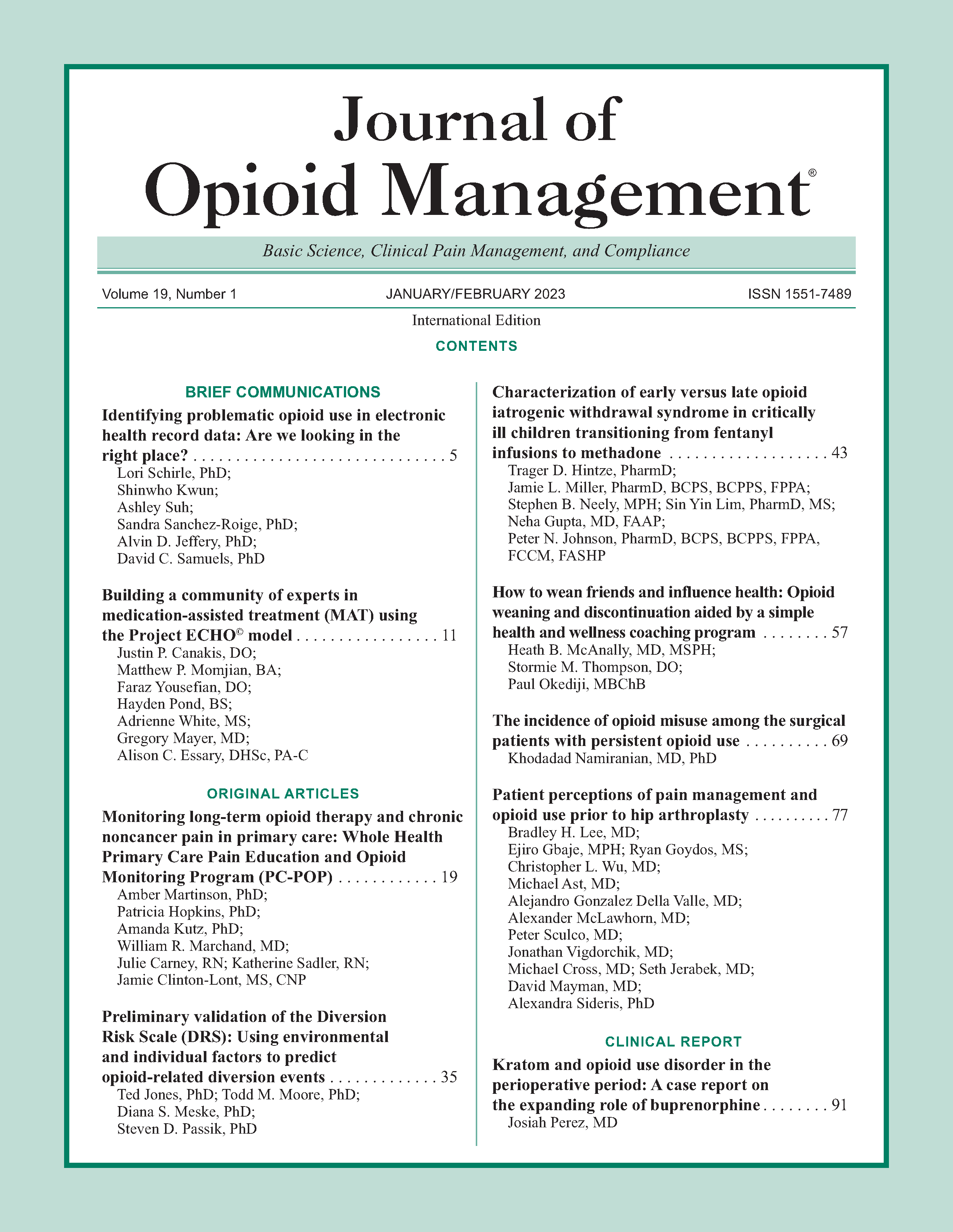Preliminary validation of the Diversion Risk Scale (DRS): Using environmental and individual factors to predict opioid-related diversion events
DOI:
https://doi.org/10.5055/jom.2023.0757Keywords:
diversion, opioid prescribing, opioid risk assessmentAbstract
The standard of care calls for the assessment of patients with chronic pain prior to the initiation of opioids, with one part of this assessment including assessment of the risk of misuse of medications. However, traditional opioid risk assessment tools focus almost entirely on individual factors and on the risk of misuse and addiction to opioids. Diversion of opioid medications has been found to be not uncommon, but to date, there have been no assessment tools specifically designed to assess the risk of diversion. In this study, we developed a measure designed specifically to assess the risk of an opioid medication ending up in the hands of someone other than the chronic pain patient to whom they were prescribed. A 15-item measure, the Diversion Risk Scale, was created and administered to 85 patients at a chronic pain practice. Results found that the measure had acceptable predictive validity. It was moderately correlated with traditional opioid risk assessment tools and showed improved ability to predict specific indicators of diversion. Diversion has been an understudied phenomenon, and the clinical value of an assessment tool that can help predict diversion in the chronic pain population is discussed.
References
Trescot AM, Helm S, Hansen H, et al.: Opioids in the management of chronic non-cancer pain: An update of American society of the interventional pain physicians’ (ASIPP) guidelines. Pain Phys. 2008; 11(2 Suppl): S5-S62.
Davis WR, Johnson BD: Prescription opioid use, misuse, and diversion among street drug users in New York city. Drug Alcohol Depend. 2008; 92(1-3): 267-276. DOI: 10.1016/j.drugalcdep.2007.08.008.
Okie S: A flood of opioids, a rising tide of deaths. N Engl J Med. 2010; 363: 1981-1985.
Fischer B, Keates A, Bühringer G, et al.: Non-medical use of prescription opioids and prescription opioid-related harms: Why so markedly higher in North America compared to the rest of the world? Addiction. 2014; 109(2): 177-181.
The Use of Opioids for the Treatment of Chronic Pain: A consensus statement from the American academy of pain medicine and the American pain society. Clin J Pain. 1997; 13(1): 6-8.
US Department of Health and Human Services: Pain management best practices inter-agency task force report: Updates, gaps, inconsistencies, and recommendations. US Department of Health and Human Services Website. 2019. Available at https://www.hhs.gov/ash/advisory-committees/pain/reports/index.html. Accessed February 1, 2019.
Gourlay DL, Heit H, Almahrezi A: Universal precautions in pain medicine: A rational approach to the treatment of chronic pain. Pain Med. 2005; 6: 107-112.
Dowell D, Haegerich TM, Chou R: CDC guideline for prescribing opioids for chronic pain—United States, 2016. J Am Med Assoc. 2016; 315(15): 1624-1645.
Webster LR, Webster RM: Predicting aberrant behaviors in opioid-treated patients: Preliminary validation of the opioid risk tool. Pain Med. 2005; 6(6): 432-442.
Adams LL, Gatchel RJ, Robinson RC, et al.: Development of a self-report screening instrument for assessing potential opioid medication misuse in chronic pain patients. J Pain Sympt Manag. 2004; 27(5): 440-459.
Butler SF, Budman SH, Fernandez K, et al.: Validation of a screener and opioid assessment measure for patients with chronic pain. Pain. 2004; 112(1-2): 65-75.
Butler SF, Fernandez K, Benoit C, et al.: Validation of the revised screener and opioid assessment for patients with pain (SOAPP-R). J Pain. 2008; 9(4): 360-372.
Jones T, Lookatch S, Moore T: Validation of a new risk assessment tool: The brief risk questionnaire. J Opioid Manag. 2015; 11(2): 171-183.
Butler SF, Budman SH, Fanciullo GJ, et al.: Cross validation of the Current Opioid Misuse Measure (COMM) to monitor chronic pain patients on opioid therapy. Clin J Pain. 2010; 26(9): 770-776.
Larance B, Bruno R, Lintzeris N, et al.: Development of a brief tool for monitoring aberrant behaviours among patients receiving long-term opioid therapy: The opioid-related behaviours in treatment (ORBIT) scale. Drug Alcohol Depend. 2016; 159: 42-52.
DEA: Final policy statement on dispensing controlled substances for the treatment of pain. Fed Regist. 2006; 71(172): 52716-52723.
Beyene KA, Aspden T, Sheridan J: Prescription medication sharing: A systematic review of the literature. Am J Public Health. 2014; 104(4): e15-e26.
Goldsworthy R, Schwartz N, Mayhorn C: Beyond abuse and exposure: Framing the impact of prescription-medication sharing. Am J Public Health. 2008; 98(6): 1115-1121.
Walker MJ, Webster LR: Risk factors for drug diversion in a pain clinic patient population. J Opioid Manag. 2012; 8(6): 351-362.
Inciardi JA, Surratt HL, Lugo Y, et al.: The diversion of prescription opioid analgesics. Law Enforc Exec Forum. 2007; 7(7): 127-141.
Inciardi JA, Surratt HL, Kurtz SP, et al.: The diversion of prescription drugs by health care workers in Cincinnati, Ohio. Subst Use Misuse. 2006; 41: 255-264.
Fox LP, Moore TM, Passik S, et al.: A pilot study: Incidence and prediction of diversion among opioid therapy patients. Pract Pain Manag. 2020; 20(5).
Jones T, Moore TM: Preliminary data on a new risk assessment tool: The brief risk interview. J Opioid Manag. 2013; 9(1): 19-27.
Jones T, Lookatch S, Grant P, et al.: Further validation of an opioid risk assessment tool: The brief risk interview. J Opioid Manag. 2014; 10(5): 353-364.
Published
How to Cite
Issue
Section
License
Copyright 2005-2025, Weston Medical Publishing, LLC and Journal of Opioid Management. All Rights Reserved.











